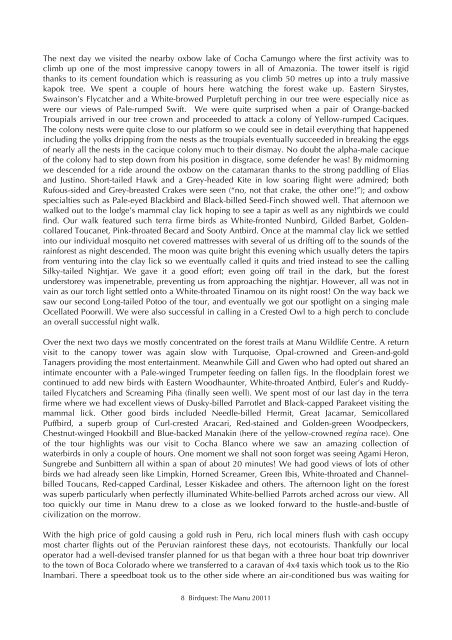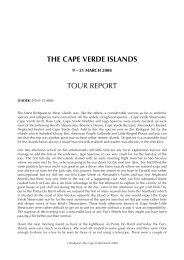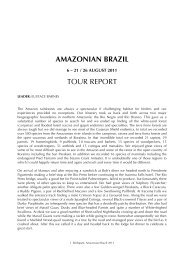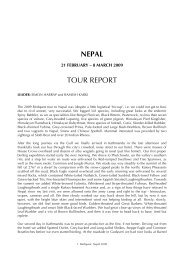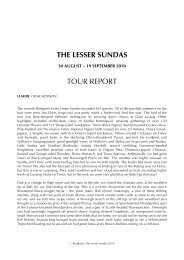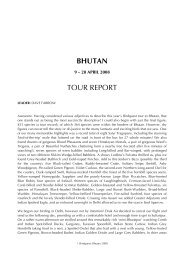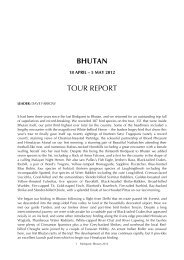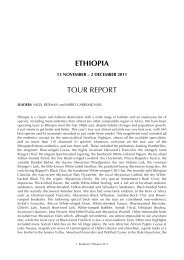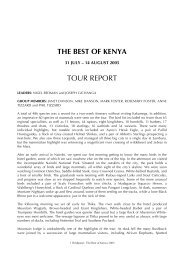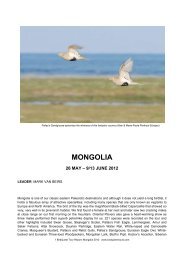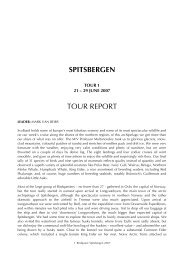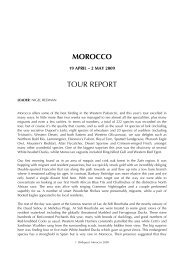Download Full Tour Report 1202kb - Birdquest
Download Full Tour Report 1202kb - Birdquest
Download Full Tour Report 1202kb - Birdquest
Create successful ePaper yourself
Turn your PDF publications into a flip-book with our unique Google optimized e-Paper software.
The next day we visited the nearby oxbow lake of Cocha Camungo where the first activity was to<br />
climb up one of the most impressive canopy towers in all of Amazonia. The tower itself is rigid<br />
thanks to its cement foundation which is reassuring as you climb 50 metres up into a truly massive<br />
kapok tree. We spent a couple of hours here watching the forest wake up. Eastern Sirystes,<br />
Swainson’s Flycatcher and a White-browed Purpletuft perching in our tree were especially nice as<br />
were our views of Pale-rumped Swift. We were quite surprised when a pair of Orange-backed<br />
Troupials arrived in our tree crown and proceeded to attack a colony of Yellow-rumped Caciques.<br />
The colony nests were quite close to our platform so we could see in detail everything that happened<br />
including the yolks dripping from the nests as the troupials eventually succeeded in breaking the eggs<br />
of nearly all the nests in the cacique colony much to their dismay. No doubt the alpha-male cacique<br />
of the colony had to step down from his position in disgrace, some defender he was! By midmorning<br />
we descended for a ride around the oxbow on the catamaran thanks to the strong paddling of Elias<br />
and Justino. Short-tailed Hawk and a Grey-headed Kite in low soaring flight were admired; both<br />
Rufous-sided and Grey-breasted Crakes were seen (“no, not that crake, the other one!”); and oxbow<br />
specialties such as Pale-eyed Blackbird and Black-billed Seed-Finch showed well. That afternoon we<br />
walked out to the lodge’s mammal clay lick hoping to see a tapir as well as any nightbirds we could<br />
find. Our walk featured such terra firme birds as White-fronted Nunbird, Gilded Barbet, Goldencollared<br />
Toucanet, Pink-throated Becard and Sooty Antbird. Once at the mammal clay lick we settled<br />
into our individual mosquito net covered mattresses with several of us drifting off to the sounds of the<br />
rainforest as night descended. The moon was quite bright this evening which usually deters the tapirs<br />
from venturing into the clay lick so we eventually called it quits and tried instead to see the calling<br />
Silky-tailed Nightjar. We gave it a good effort; even going off trail in the dark, but the forest<br />
understorey was impenetrable, preventing us from approaching the nightjar. However, all was not in<br />
vain as our torch light settled onto a White-throated Tinamou on its night roost! On the way back we<br />
saw our second Long-tailed Potoo of the tour, and eventually we got our spotlight on a singing male<br />
Ocellated Poorwill. We were also successful in calling in a Crested Owl to a high perch to conclude<br />
an overall successful night walk.<br />
Over the next two days we mostly concentrated on the forest trails at Manu Wildlife Centre. A return<br />
visit to the canopy tower was again slow with Turquoise, Opal-crowned and Green-and-gold<br />
Tanagers providing the most entertainment. Meanwhile Gill and Gwen who had opted out shared an<br />
intimate encounter with a Pale-winged Trumpeter feeding on fallen figs. In the floodplain forest we<br />
continued to add new birds with Eastern Woodhaunter, White-throated Antbird, Euler’s and Ruddytailed<br />
Flycatchers and Screaming Piha (finally seen well). We spent most of our last day in the terra<br />
firme where we had excellent views of Dusky-billed Parrotlet and Black-capped Parakeet visiting the<br />
mammal lick. Other good birds included Needle-billed Hermit, Great Jacamar, Semicollared<br />
Puffbird, a superb group of Curl-crested Aracari, Red-stained and Golden-green Woodpeckers,<br />
Chestnut-winged Hookbill and Blue-backed Manakin (here of the yellow-crowned regina race). One<br />
of the tour highlights was our visit to Cocha Blanco where we saw an amazing collection of<br />
waterbirds in only a couple of hours. One moment we shall not soon forget was seeing Agami Heron,<br />
Sungrebe and Sunbittern all within a span of about 20 minutes! We had good views of lots of other<br />
birds we had already seen like Limpkin, Horned Screamer, Green Ibis, White-throated and Channelbilled<br />
Toucans, Red-capped Cardinal, Lesser Kiskadee and others. The afternoon light on the forest<br />
was superb particularly when perfectly illuminated White-bellied Parrots arched across our view. All<br />
too quickly our time in Manu drew to a close as we looked forward to the hustle-and-bustle of<br />
civilization on the morrow.<br />
With the high price of gold causing a gold rush in Peru, rich local miners flush with cash occupy<br />
most charter flights out of the Peruvian rainforest these days, not ecotourists. Thankfully our local<br />
operator had a well-devised transfer planned for us that began with a three hour boat trip downriver<br />
to the town of Boca Colorado where we transferred to a caravan of 4x4 taxis which took us to the Rio<br />
Inambari. There a speedboat took us to the other side where an air-conditioned bus was waiting for<br />
8 <strong>Birdquest</strong>: The Manu 20011


